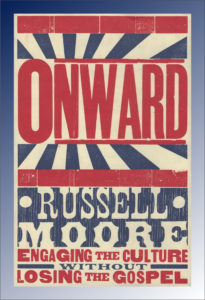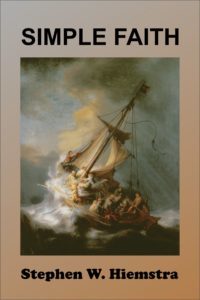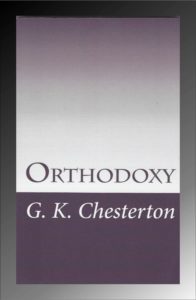Stephen W. Hiemstra's Blog, page 213
February 13, 2018
Moore Engages Secular Culture, Part 1
 Russell Moore. 2015. Onward: Engaging the Culture without Losing the Gospel. Nashville: B & H Publishing Group. (Goto part 2)
Russell Moore. 2015. Onward: Engaging the Culture without Losing the Gospel. Nashville: B & H Publishing Group. (Goto part 2)
Review by Stephen W. Hiemstra
In the fall of 2013 I attended the annual conference of the Evangelical Theological Society (ETS) to visit with book publishers about my first book, A Christian Guide to Spirituality. While I spent most of my time with the publishers, I attended a luncheon sponsored by the Colson Center where I got a chance to hear Russell Moore speak. He impressed me enough that I looked up and purchased a copy of his book, Onward: Engaging the Culture without Losing the Gospel.
Overview
In his acknowledgments, Moore writes:
“In some sense, I’ve been writing this book all my life, seeking to articulate what I believe about the relationship between the kingdom of God and the cultures of this present age.” (223)
In further highlighting the themes of his book, he writes:
“As the culture changes all around us, it is no longer possible to pretend that we are a Moral Majority. That may be bad news for America, but it is good news for the church…we need a church that speaks to social and political issues with a bigger vision in mind: that of the gospel of Jesus Christ.” (back cover)
“Moore is the president of the Ethics and Religious Liberty Commission of the Southern Baptist Convention,” (back flap) which is the largest Protestant denomination in in the United States.
The need to cite these summary statements arises, in part, because Moore writes primarily in narratives, avoiding the usual academic convention of a stating a major premise and outlining how it will be demonstrated. His use of narratives is interesting because it forces opponents to lesson to his entire presentation before jumping in to offer objections.
Outline
Moore writes his book in ten chapters that highlight major themes in his thinking:
“A Bible Belt No More
From Moral Majority to Prophetic Minority
Kingdom
Culture
Mission
Human Dignity
Religious Liberty
Family Stability
Convictional Kindness
A Gospel Counter-Revolution” (ix)
These chapters are preceded by an introduction and followed by a conclusion and acknowledgments sections.
God and Country
What makes Moore so interesting to read is that he accepts the premise that we live in a post-Christian society and he proceeds to deconstruct America’s pagan culture laying bare some of its most cherished myths.
The myths of a “Moral Majority” or the existence of a “Bible Belt”, in Moore’s view, were always more about shared values than about the Gospel of Jesus Christ.
As an Eagle Scout myself, I found Moore’s discussion of his travails in trying to earn the God and Country badge most entertaining. As a Scout teen, he asked:
“Can a Christian be possessed by a demon, or are we protected from that by the indwelling of the Holy Spirit?” (11)
This question, of course, set his Methodist pastor advisor to squirming and the pastor eventually admitted that he did not believe in demons, but more to the point the question unmasked the real intent of the Scout badge of instilling just enough Christianity to “fight the Communists and save the republic”, but not enough to have spiritual significance. His leaders wanted to instill the shared values of a kind of civic religion while as a kid Moore just “didn’t want to risk projectile vomiting demonic ooze.” (12) Never mind that an answer to Moore’s question continues to distinguish American denominations.
Assessment
In part 1 of this review, I give an overview of Moore’s book. In part 2, I will drill down into some of his arguments.
Russell Moore’s Onward: Engaging the Culture without Losing the Gospel challenges us to distinguish the gospel of Jesus Christ from different manifestations of Christendom in American culture. Moore advocates engaging the culture, not simply criticizing it, to expose aspects of the culture that present opportunities for Christian witness. His narrative style facilitates this engagement and makes his writing both entertaining and accessible.
Jackson Watts, ETS 2013: Inerrancy in Perspective (http://www.helwyssocietyforum.com/?p=...).
https://www.RussellMoore.com. @DRMoore.
Moore Engages Secular Culture, Part 1
Also see:
Books, Films, and Ministry
Other ways to engage online:
Author site: http://www.StephenWHiemstra.net, Publisher site: http://www.T2Pneuma.com.
Newsletter at: http://bit.ly/2zRkNMJ
The post Moore Engages Secular Culture, Part 1 appeared first on T2Pneuma.net.
February 11, 2018
Thanks for Quiet Days
 By Stephen W. Hiemstra
By Stephen W. Hiemstra
Oh dear Lord,
Thank you for quiet days,
when nothing needs to be done,
when the rain seems endless,
and when we can recover from the turbulence of life.
Be especially close.
Guard our worn out hearts.
Keep us from sinning.
In the power of your Holy Spirit,
heal our wounds.
In Jesus’ precious name, Amen.
Thanks for Quiet Days
Also see:
Giving Thanks
A Place for Authoritative Prayer
Other ways to engage online:
Author site: http://www.StephenWHiemstra.net, Publisher site: http://www.T2Pneuma.com.
Newsletter at: http://bit.ly/2BKihbl
The post Thanks for Quiet Days appeared first on T2Pneuma.net.
February 9, 2018
Decisions Under Uncertainty
 By Stephen W. Hiemstra
By Stephen W. Hiemstra
Decisions that we make are often assumed to be made in a context of certainty about outcomes. We use language like, if I do A, then B will follow, as if we knew the outcome with absolute certainty. This is an unrealistic assumption, but we assume it anyway to keep things easy, at least for purposes of explaining our decisions to ourselves or others.
Why Do We Assume Certainty?
Part of the reason for this simplistic assumption is that decision making creates anxiety. The future is never known for sure and important decisions can affect outcomes, our state of mind, and how others view our competency. Our anxiety levels go down when we are confident of our ability to make decisions and have experience showing that our competency is justified.
Experience with Decision Making
In my own experience, my decision skills improved greatly when I traded commodities, stocks, and options. Timely decision making was important as a trader and my decisions had previously been marked by “analysis paralysis,” a condition where the decision maker keeps procrastinating in the hope of gathering more information. In trading, analysis paralysis proved costly because buying opportunities quickly disappear in a competitive market. My training as a trader proved costly, but I learned how to assess information requirements quickly and to limit the markets that I traded so I could act quickly without a high level of uncertainty. I also learned to cut my losses when the market did not perform as expected.
Cutting one’s losses quickly is important in other contexts. Suppose that I worked in a particular field for a number of years only to find that my chosen field was no longer “hot”. If I continued to work in that field and to deny the lack of interest of my employers, my career would suffer even if I retained my position. Suppose that I reached a certain age and no longer needed to work to earn a living in a stressful job. If I continued to work anyway because the money was good and ignored the effect of the stress on my health and on my family.
Uncertainty Affects All Aspects of Decisions
Going back to our original example of a decision—if A, then B—we have at least three sources of uncertainty in this simple equation.
First, what if condition A is only partially met or if we are mistaken in our ability to trigger this condition? If I want to purchase a car, I need to have the money necessary for the purchase. What if I do not have the cash and do not know if a lender to make me a loan?
Second, what if the relationship between A and B changes? Suppose I raise the money to buy the car, but it is no longer available for sale?
Third, what if I raise the money for my car and it is still available for sale, but the dealer package does not include the features that I really wanted, like perhaps a car radio or guidance system or air conditioning, at the price originally quoted?
Uncertainty is Especially a Problem with Investment Decisions
While buying a car can raise a number of issues in itself, the uncertainty level rises when the car is needed to make an investment decision or needs to be paid out of future earnings. What if I am starting a new job as a traveling salesman, what car is most suitable for my new position? Suitability might take the form of having seats that remain comfortable after a six hour drive so that I can meet with customers in a relaxed manner. Or it might take the form of safety features that prevent accidents in the case of narcolepsy.
If my investment in a new car needs to be paid out of my earnings as a salesman and my future earnings are in question, my ability to repay my automobile loan needs to be estimated and may depend on events that I have no control over.
The same problem arises in making decisions about education. In college when I decided to study economics, I had no idea what an economist could expect to earn and whether studying economics posed a profitable investment decision, but I knew that my father had studied economics and was able to earn a living. I took it on faith that if I followed my father into the economics profession, I would earn a similar income and be able to support a family. In a formal sense, however, I did not (and perhaps could not) make a rational decision based on current expected earnings in the economics profession.
Decisions Under Uncertainty
Also see:
A Roadmap of Simple Faith
Christian Spirituality
Looking Back
A Place for Authoritative Prayer
Other ways to engage online:
Author site: http://www.StephenWHiemstra.net, Publisher site: http://www.T2Pneuma.com.
Newsletter: http://bit.ly/2BKihbl
The post Decisions Under Uncertainty appeared first on T2Pneuma.net.
February 6, 2018
Ten Most Popular Reviews over Last 12 Months
 Art by Stephen W. Hiemstra
Art by Stephen W. HiemstraBy Stephen W. Hiemstra
It is helpful from time to time to review the most popular postings. Notice how many older postings continue to attract readers even now. The James Plueddemann book, Leading Across Cultures, is consistently the single most popular posting on T2Pneuma. This highly theological textbook is of most interest to missionaries, foreign and domestic.
Review Title (Click to Read)
Date Posted
Views
Plueddemann Demystified Leadership Across Culture
3/31/2014
65
Stone and Duke Encourage Theological Reflection
7/19/2016
30
Nouwen: Make Space for Self, Others, and God
5/3/2016
21
Murrow Invites Churches to be Man-friendly
4/29/2015
19
Teague Gives MailChimp a Spin
12/26/2017
17
Nouwen Describes Leadership Challenges
10/3/2017
14
Meeks Explains Amazon Ads (2)
11/7/2017
12
Heifetz and Linsky Lead through Adversity
6/4/2014
12
Tim Keller Makes Sense, Part 1
10/10/2017
12
Rice Reclaims Reformed Spirituality
12/2/2013
11
Ten Most Popular Reviews over Last 12 Months
Also see:
Books, Films, and Ministry
Other ways to engage online:
Author site: http://www.StephenWHiemstra.net, Publisher site: http://www.T2Pneuma.com.
Newsletter at: http://bit.ly/2zRkNMJ
The post Ten Most Popular Reviews over Last 12 Months appeared first on T2Pneuma.net.
February 4, 2018
Prayer for the Silent People
 Art by M. Naris Hiemstra
Art by M. Naris HiemstraBy Stephen W. Hiemstra
Almighty Father,
All praise and honor be yours, Lord, for bringing caring people into my life.
For I am not an island, much as I would like to be.
For my freedom in Christ is to live within your healthy boundaries,
not to do everything that my sinful nature might desire.
I confess, Lord,
that I forget to raise my concerns up in prayer and to pray over the many decisions that I face each day;
that my desires would destroy me, were I to yield to them;
that I am totally dependent on your goodness and mercy every day of my life.
But I give thanks for your Holy Spirit’s guidance, provision, and placing of many saints in my life.
Help me to remember the silent people–
those forgotten because their social status,
those unseen because their work masquerades in products and services that I barely understand,
those that I am simply too busy or proud to recognize and honor.
Bless them. May I learn to honor them daily.
In Jesus’ precious name, Amen.
Prayer for the Silent People
Also see:
Giving Thanks
A Place for Authoritative Prayer
Other ways to engage online:
Author site: http://www.StephenWHiemstra.net, Publisher site: http://www.T2Pneuma.com.
Newsletter at: http://bit.ly/2BKihbl
The post Prayer for the Silent People appeared first on T2Pneuma.net.
February 2, 2018
The Immaturity Problem
 By Stephen W. Hiemstra
By Stephen W. Hiemstra
Decisions in a society focused on youth culture pose a special problem because of the refusal of many to shoulder responsibility for their actions. As mentioned previously, in an ideal world we would approach important decisions as well-informed adults who understand our own weaknesses and consider carefully the options presented to us, taking our time to consult with our mentors, friends, and family and being devoid of dysfunctions, like mental illness or drug use. Even in the absence of external manipulation, youth culture undermines decision-making out of ignorance, impatience, and unwillingness to rectify obvious dysfunction.
The Designated Adult
Families and organizations manage to survive in this environment, not by encouraging greater rationality, but by weakly tolerating a few designated adults who tirelessly attempt to hold things together while many others simply party on. Family systems theory refers to this phenomena as “overfunctioning” (Friedman 1985, 210-212). Gilbert (2006, 17) notes that the overfunctioning individual usually pairs up with an underfunctioning individual to form one functioning person out of two.
In a church context, a pastor may be hired to rescue the congregation from a decline in membership only to find that members refuse to accept the new members that the pastor welcomes into the church. Churches of this sort may go through a series of pastors and eventually close their doors because the members refuse to adapt to and accept the changing demographics of their community. Parents unwilling or unable to practice “tough love” may find themselves saddled with caring for children that fail to launch and for grandchildren engendered by the same.
The One-off Solution
Postmodern culture encourages this behavior by refusing to insist that participants hold an internally consistent set of values and preferring one-off solutions.
Probably the most obvious example of this problem arises with the American drug culture that arises, in part, as the dark side of the propensity of Americans to place too high a value of an unsustainable work ethic. When attempts to compete in this unsustainable work culture fail, recreational drug use spirals into addiction and destroys any possibility of further advance in one’s career. At the heart of the problem is the attempt to live a licentious lifestyle alongside of a career that requires exacting personal discipline.
In this example, recreational drug use is proffered as a one-off solution to the problem of stress. Instead, of living a balanced lifestyle with time devoted both to work and self-care, the worker self-medicates and skips the trip to the gym or the family outing. Drug use starts out as the solution to the problem of stress through self-medication, not perceived as a problem in itself.[1] This confusion between problem and solution can lead to addiction, but—more to the point—it began by trying to find a one-off solution to the problem of stress, rather than mitigating the stress itself.
When the usual pattern of problem solving is to seek a one-off solution—looking for a pill to solve our health problem—we are less likely to perceive the spiritual problem that may be behind many of life’s challenges.
More than the Usual Background Noise
Every age has had its distractions. The postmodern era stands out because the volume of the background noise has been turned up significantly while the usual institutions—family, church, community—for dealing with it have been seriously weakened. It is now up to the individual to turn off the cell phone, computer, and other media or, alternatively, screen the massive amount of information available for specific information of use in making decisions. Meanwhile, the pace of life and work has accelerated rendering this filtering process for the conscientious decision maker more difficult.
But not everyone steps up to this challenge.
Presented with an overstimulating environment, many people opt simply to check out, self-medicate, or insulate themselves with white noise—the omnipresent headset, the television never turned off, or refusing to leave their rooms or other comforting environments. This latter option functions much like rumination that keeps the individual from reflecting on their daily challenges as they obsess about events in the past, especially past trauma. The individual who ruminates (or employs white noise) essentially refuses to think about current decisions and, as a consequence, frustrates their own maturing process becoming developmentally impaired.
Decisions in a Sub-Optimal Decision Environment
The problem of relying on designated adults, rather than aspiring to maturity, and habit of seeking one-off solutions both undermine the decision environment that many people face in the postmodern era. Many people reach the age of consent or of legal maturity well before they are able to function as self-reliant adults leaving them unable to make good decisions, vulnerable to manipulation, and unable to advance spiritually.
References
Clinebell Jr, Howard J. 1978. Understanding and Counseling the Alcoholic Through Religion and Psychology (Orig. Pub. 1956) Nashville: Abingdon.
Friedman, Edwin H. 1985. Generation to Generation: Family Process in Church and Synagogue. New York: Guilford Press.
Gilbert, Roberta M. 2006. The Eight Concepts of Bowen Theory: A New Way of Thinking about the Individual and the Group. Front Royal (VA): Leading Systems Press.
Footnotes
[1] Clinebell (1978, 19) observes: “Does the person’s drinking frequently or continuously interfere with his social relations, his role in the family, his job, his finances, or his health? If so, the changes are that that person is an alcoholic or on the verge of becoming one.”
The Immaturity Problem
Also see:
A Roadmap of Simple Faith
Christian Spirituality
Looking Back
A Place for Authoritative Prayer
Other ways to engage online:
Author site: http://www.StephenWHiemstra.net, Publisher site: http://www.T2Pneuma.com.
Newsletter: http://bit.ly/2BKihbl
The post The Immaturity Problem appeared first on T2Pneuma.net.
January 30, 2018
Dayton Explores Evangelical History
 Donald W. Dayton. 2005. Discovering An Evangelical Heritage (Orig. Pub. 1976). Peabody: Hendrickson.
Donald W. Dayton. 2005. Discovering An Evangelical Heritage (Orig. Pub. 1976). Peabody: Hendrickson.
Review by Stephen W. Hiemstra
I heard Dayton speak in September 2006 at Wesley Theology Seminary here in Washington DC. Dayton was the guest speaker at chapel (something about a 30-year anniversary of the book and an award from the seminary). His address focused on the many faces of John Wesley—something new and interesting to me. His talk prompted me to buy the book, Discovering an Evangelical Heritage, and another of his books, The Theological Roots of Pentecostalism.
The book is interested me because he dials back to the period of Charles Finney during the second Great Awakening. Finney was the Billy Graham of his day. Unlike Graham, Finney was both a great revivalist and a social reformer. Apparently, early evangelicals were at the forefront of the campaigns to abolish slavery, promote woman’s rights, and advocating temperance. While I knew some of the history of this reforms, I did not specifically associate these reforms with 19th-century evangelicals and the Second Great Awakening until reading Dayton.
Dayton’s historical review includes chapters on abolition of slavery, women’s rights, and temperance. Key personalities and financial supporters of these movements were discussed. The roles of Oberlin College and different seminaries (Princeton, Gordon-Conwell, and others) in social reforms (or not) of the 19th century were especially interesting to me.
So why did American Evangelicals come to focus on evangelism and less on social reform? Dayton explains the difference in evangelical attitudes about social reform to a number of things. Among these were disillusionment following the Civil War, a less optimistic view of the impact of sin, and a switch from post-millennial to pre-millennial eschatological views. According to Dayton, if you believe that Christians will be raptured the moment Christ returns rather than after a thousand years of Christ’s rule, then evangelism takes a higher priority and social reform goes down in priority.
I found Dayton’s analyses of these events credible, informative, and insightful—much like his talk. I can see why Wesley Theological Seminary presented him with an award.
References
Donald W. Dayton. 2004. Theological Roots of Pentecostalism. Metuchen NJ: Hendrickson Publishers (Review: https://wp.me/p8RkfV-xO).
Dayton Explores Evangelical History
Also see:
Dayton: Remembering the Story of Pentecostalism
Tennant Highlights Five Gifts
Books, Films, and Ministry
Other ways to engage online:
Author site: http://www.StephenWHiemstra.net, Publisher site: http://www.T2Pneuma.com.
Newsletter at: http://bit.ly/2zRkNMJ
The post Dayton Explores Evangelical History appeared first on T2Pneuma.net.
January 28, 2018
Prayer for Presence and to be Present
 Route 28, Manassas, Virgina
Route 28, Manassas, Virgina
By Stephen W. Hiemstra
Heavenly Father,
I praise you for your quiet presence,
sustaining all creation and provisioning it with your love.
Though darkness cover us and we fear the death that is ever-near,
you cover us with the blood of Christ, your hedge of everlasting protection.
Cover my sin–the times that my judgment lapses,
and I cannot even admit my transgressions to myself.
Thankfully, you do not share my weaknesses and we can rejoice in your goodness,
even when we are alone and walk in the dark night of the soul.
In the power of your Holy Spirit,
grant us the strength to model your presence to those around us,
the grace to model your goodness,
and the peace that passes all understanding.
In Jesus’ precious name, Amen
Prayer for Presence and to be Present
Also see:
Giving Thanks
A Place for Authoritative Prayer
Other ways to engage online:
Author site: http://www.StephenWHiemstra.net, Publisher site: http://www.T2Pneuma.com.
Newsletter at: http://bit.ly/2jaUhI7
The post Prayer for Presence and to be Present appeared first on T2Pneuma.net.
January 26, 2018
Why Do We Care About Learning Processes?
 By Stephen W. Hiemstra
By Stephen W. Hiemstra
The process of learning affects the quality of our decisions, especially when it comes to faith decisions, and how we respond to external manipulation. While reflecting on the learning process may sound academic and perhaps boring, the learning process plays a critical role in our faith journey.
In an ideal world, we would approach important decisions as well-informed adults who understand our own weaknesses and consider carefully the options presented to us, taking our time to consult with our mentors, friends, and family and being devoid of dysfunctions, like mental illness or drug use.[1] In the postmodern world, advertisers encourage us to behave like kids, who deny that bad habits are bad and rush to make decisions based on the latest fad rather than careful reflection, discounting any advice offered by friends and family. The youth culture that dominates postmodern life offers an advertiser’s paradise.
If you believe that modern media is irrelevant to your religious life, then ask yourself a couple of questions. For example, why are most sermons about 20 minutes? and where do you go when you get upset? Twenty minute is about the amount of time remaining in a 30 minutes television show after the time devoted to advertising is subtracted out. If you go shopping when you are anxious, then consider what your grandmother might have done—50 years ago it was common to go to a chapel and pray on stressful occasions.[2] Today, if someone wanted to pray in a chapel, the door would likely be locked.
In his book, Winning the Story Wars, Jonah Sacks talks about the contribution of dark art of marketing to cultural changes that we have seen. Borrowing from the work of Joseph Campbell, Sacks describes the purpose of myth (story-telling) is to help us grow up because we yearn for maturation. But mature adults (self-responsible, free agents) threaten marketers who typically prefer us to remain adolescents where we suspended in an immature state dwelling on emotions like greed, vanity, and insecurity—the bottom rung in Abraham Maslow’s pyramid of needs.[3] In this immature state, we are encouraged to feel inadequate and incomplete where consumption of product X, Y, Z can presumably make us complete again (Sacks 2012, 85-86).
Inadequacy marketing directly assaults the spirit of most religious teaching, irrespective of theology, because most religions aid our maturation and help us to contribute to society. Hence, the phrase—the dark art of marketing—is truly dark because the advertiser works explicitly to undermine rational decision processes, stroke anxieties, and tell us stories that sell their products at the expense of undermining our own self-worth.
Through unconscious and voluminous repetition, this advertising entertains us daily like the air that we breathe and it shapes our perceptions, leaving us impatient for catchy phrases, tunes, and images. When our children say that church is boring, they simply observe that the pastor cannot offer the same catchy phrases, tunes, and images that they see on their cell phones every day. As parents, pastors, and teachers, postmodern culture outguns us on daily basis, unless we focus on the learning process and how decisions really get made.
References
Maslow, Abraham H. (1943). “A theory of human motivation”. Psychological Review. 50 (4): 370–96.
Plantinga, Alvin. 2000. Warranted Christian Belief. New York: Oxford University Press.
Sacks, Jonah. 2012. Winning the Story Wars: Why Those Who Tell—and Live—the Best Stories Will Rule the Future. Boston: Harvard Business School Press.
Footnotes
[1] Plantinga (2000, 108-134) wrote at length about the proper function of decision making and defining rationality with philosophical precision.
[2] In Hispanic films, people still consult a priest and/or visit a chapel to pray, but not in English language films. The last example of a chapel visit in film that I remember was in Home Alone (1990) starring Macaulay Culkin, Joe Pesci, and Daniel Stern.
[3] Maslow pictured a pyramid of needs in which the foundational needs were physiological, followed by safety, love and belonging, self-esteem, and self-actualization at the top of the pyramid (Sacks 2012, 130).
Why Do We Care About Learning Processes?
Also see:
A Roadmap of Simple Faith
Christian Spirituality
Looking Back
A Place for Authoritative Prayer
Other ways to engage online:
Author site: http://www.StephenWHiemstra.net, Publisher site: http://www.T2Pneuma.com.
Newsletter at: http://bit.ly/2jaUhI7
The post Why Do We Care About Learning Processes? appeared first on T2Pneuma.net.
January 23, 2018
Chesterton Explains His Faith Journey
 G.K. Chesterton. 2017. Orthodoxy (Orig. Pub. 1908). Satya Books.
G.K. Chesterton. 2017. Orthodoxy (Orig. Pub. 1908). Satya Books.
Review by Stephen W. Hiemstra
For those that are curious and think for themselves, many of the best known critics of the Christian faith come up short. The heart of atheism is not a philosophical critique of faith; it is a willful disrespect for all forms of authority, especially divine authority. The reasons for disbelief often border on mere slander of the faith, which becomes obvious as inconsistent criticisms morph over time and show themselves in conflict. Apologetics accordingly begins to resemble the case of the parent trying to reason with tired child when a good nap (or firm discipline) is needed.
Introduction
In his book, Orthodoxy, Gilbert Keith (better known as G.K.) Chesterton sets out to explain how he came to faith in his own words, the words and arguments that ultimately convinced him. In a puckish response to a question posed by his publisher, Chesterton recounts:
“‘Well, if a man is not to believe in himself, in what is he to believe?’ After a long pause, I replied, ‘I will go home and write a book in answer to that question.’ This is the book that I have written in answer to it.” (7)
When is the last time that you wrote a book to win an argument? Obviously, Chesterton (1874-1936) lived at a time when a “lettered” (“English writer, poet, philosopher, dramatist, journalist, orator, lay theologian, biographer, and literary and art critic”) man took his arguments seriously.
Orthodoxy Defined
Chesterton defines orthodoxy in these words:
“When the word ‘orthodoxy’ is used here it means the Apostles’ Creed, as understood by everybody calling himself Christian until a very short time ago and the general historic conduct of those who held such a creed.” (5)
Belief in the Apostles’ Creed, summarized in five fundamentals of the faith:
The inerrancy of scripture;
The virgin birth of Jesus;
The doctrine of substitutionary atonement (Christ died for our sins);
The bodily resurrection of Christ; and
The miracle-working power of Christ (Longfield 1991, 9, 78)
were required for ordination as a Presbyterian pastor between 1910 and 1925. After 1925, one could be ordained without believing the Apostles’ Creed (the liberal view) and, if you persisted in believing the creed, you would be described pejoratively as a “fundamentalist.” Thus, Chesterton’s simple definition anticipated a crisis that had not yet divided the American church, but even today lies at the heart of the culture wars.
Lampoon Champ
Chesterton spends considerable time in his book lampooning his critics for their inconsistencies. He writes:
“certain sceptics wrote that the great crime of Christianity had been its attack on the family; it dragged women to the loneliness and contemplation of the cloister, away from their homes and their children. But, then, other sceptics (slightly more advanced) said that the great crime of Christianity was the family and marriage upon us; that it doomed women to the drudgery of their homes and children, and forbade them loneliness and contemplation.” (79-80)
Clearly, this argument is dated, but the inconsistencies persist. Who, for example, remembers that the first co-educational college in America, Oberlin College, was started by two Presbyterian pastors and that the famous evangelist, Charles Finney, served as its president from 1850 to 1866? The feminist movement started as evangelical Christian movement (see Gal 3:28) and it is only after the Civil War that the woman’s movement took a secular turn (Dayton 1976, 121-135). Hopefully, Chesterton will be forgiven for his candid (and dated) comments on this issue.
Coming To Faith
So why did Chesterton adopt the Christian faith? He writes:
“my reason for accepting the religion and not merely the scattered and secular truths out of the religion. I do it because the thing has not merely told this truth or that truth, but has revealed itself as a truth-telling thing.” (146)
In my own experience, I have found critics quite willing to pick at this or that doctrine that they do not understand or accept without substituting an equally valuable replacement. Christianity as a faith fits the whole person and the entirety of life’s experiences better than competing religions and philosophies which is why it is found throughout the entire world, unlike other faiths that favor one or another ethnic group and region. Mere critics normally do not accept responsibility for their partial criticisms—they steal a person’s hope and faith, and leave their victims in despair. Such actions clearly troubled Chesterton as he weighed his options.
Assessment
G.K. Chesterton’s Orthodoxy is a challenging but interesting read. He is challenging to read because he is better versed in philosophy and apologetics than most readers and his arguments often hinge on subtle word-play and knowledge of events and readings. Still, Chesterton is interesting to read because he writes roughly a hundred years ago and yet speaks directly to our own context. Read and enjoy!
References
Bradley J. Longfield. 1991. The Presbyterian Controversy: Fundamentalists, Modernists, and Moderates. New York: Oxford University Press. (Review: https://wp.me/p8RkfV-11c).
Dayton, Donald W. 1976. Discovering an Evangelical Heritage. Peabody: Hendrickson.
Footnotes
Satya is the Sanskrit word for truth (https://en.wikipedia.org/wiki/Satya).
https://en.wikipedia.org/wiki/G._K._C....
Chesterton Explains His Faith Journey
Also see:
Longfield Chronicles the Fundamentalist/Liberal Divide in the PCUSA, Part 1
Books, Films, and Ministry
Other ways to engage online:
Author site: http://www.StephenWHiemstra.net, Publisher site: http://www.T2Pneuma.com.
Newsletter at: http://bit.ly/2zRkNMJ
The post Chesterton Explains His Faith Journey appeared first on T2Pneuma.net.



